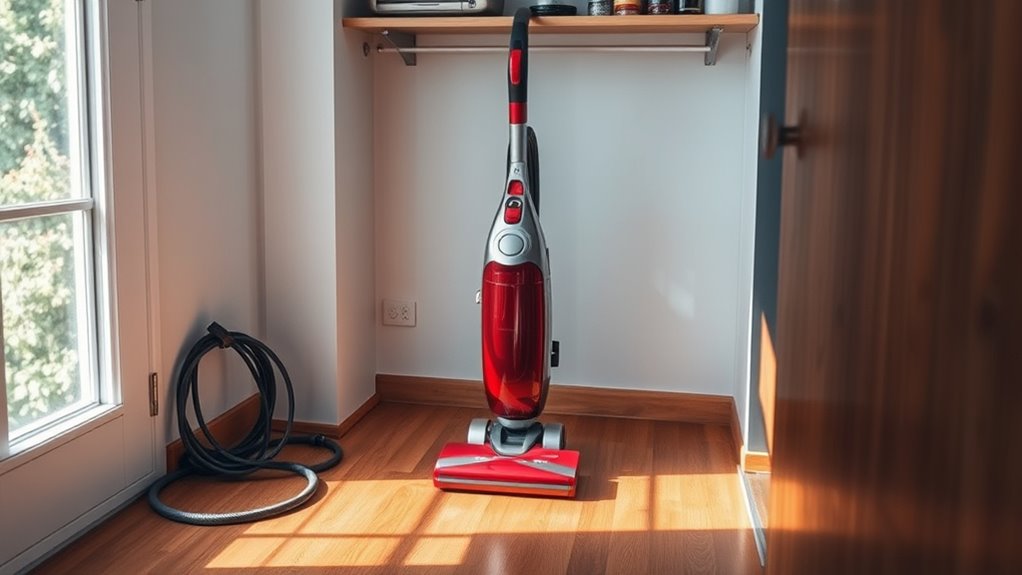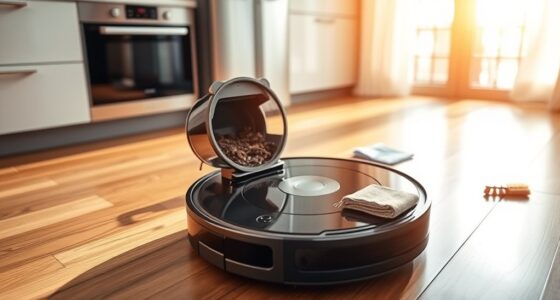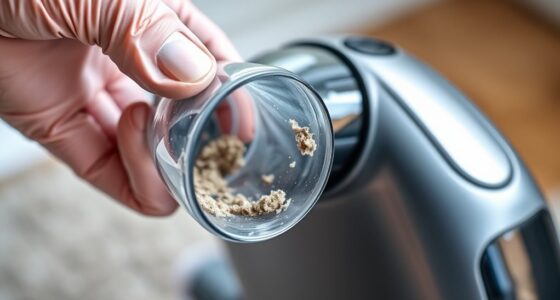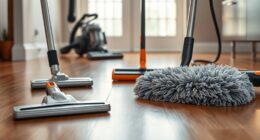To properly store your vacuum and prevent damage, start by cleaning it thoroughly. Empty the dustbin, clean the filters, and check for clogs. Choose a storage spot that’s ventilated and away from extreme temperatures. Keep it out of direct sunlight and clutter. Use wall hooks or under-bed storage to save space, and consider a breathable cover to protect it from dust. Want to know more tips for ideal storage? Keep going!
Key Takeaways
- Clean the vacuum thoroughly, including filters and dustbins, to prevent odors and maintain performance before storage.
- Choose a dry, ventilated storage location away from extreme temperatures and direct sunlight to protect the vacuum from damage.
- Use breathable covers for dust protection while allowing air circulation; avoid plastic to prevent moisture buildup.
- Organize storage with labeled boxes for removable parts and utilize multifunctional furniture to keep the vacuum accessible yet discreet.
- Charge cordless vacuum batteries to around 50% and ensure all parts are completely dry before long-term storage to prevent rust and mold.
Clean Before Storing
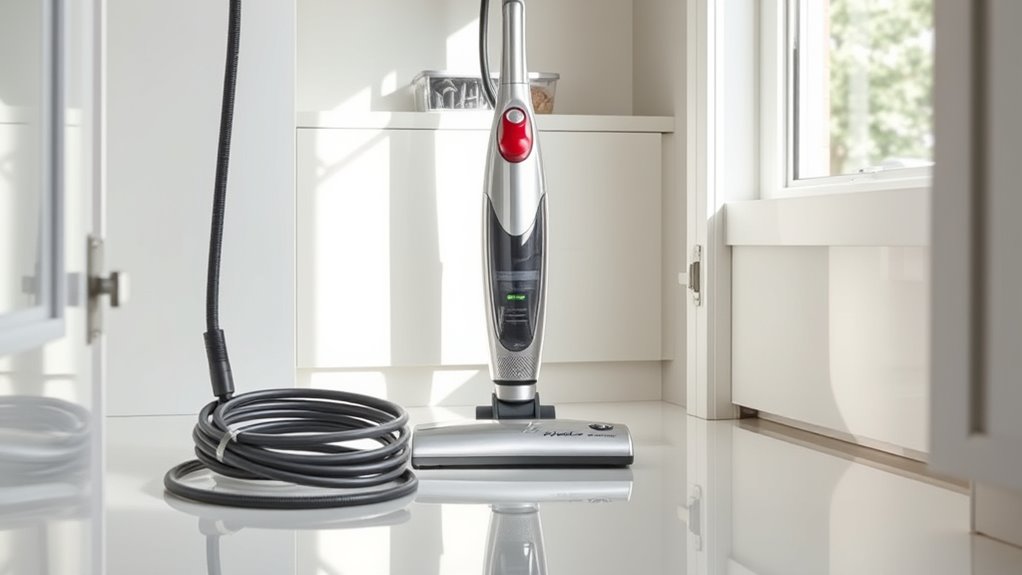
Before you tuck your vacuum away, make sure to clean it thoroughly. Start by emptying the dustbin or replacing the bag to prevent odors and damage from trapped dirt.
Next, clean the filters according to the manufacturer’s instructions; this helps maintain peak suction power for your next use. Don’t forget to remove any debris from the exterior to keep it looking tidy and to avoid dust accumulation while stored.
Check for clogged hoses or attachments and clear them out, ensuring your vacuum operates effectively later. Additionally, storing your vacuum with HEPA filters can significantly help with allergen control when you use it again.
Finally, inspect for signs of wear or damage, as addressing these issues now can extend your vacuum’s lifespan. Proper maintenance before storage sets you up for success when it’s time to clean again.
Choose the Right Storage Location

After cleaning your vacuum, the next step is to choose the right storage location. Selecting a suitable spot will help protect it from damage and guarantee it’s ready for use when you need it.
Consider these factors:
- Guarantee proper ventilation to prevent moisture buildup.
- Avoid storing it in attics or garages with extreme temperature fluctuations.
- Keep the area clutter-free to make access easier.
- Store it away from direct sunlight to prevent fading and brittleness.
- Consider proximity to power outlets for easy charging, especially for cordless models. Additionally, ensure that the storage space is free from airborne pollutants to maintain the vacuum’s efficiency and longevity.
Creative Storage Solutions
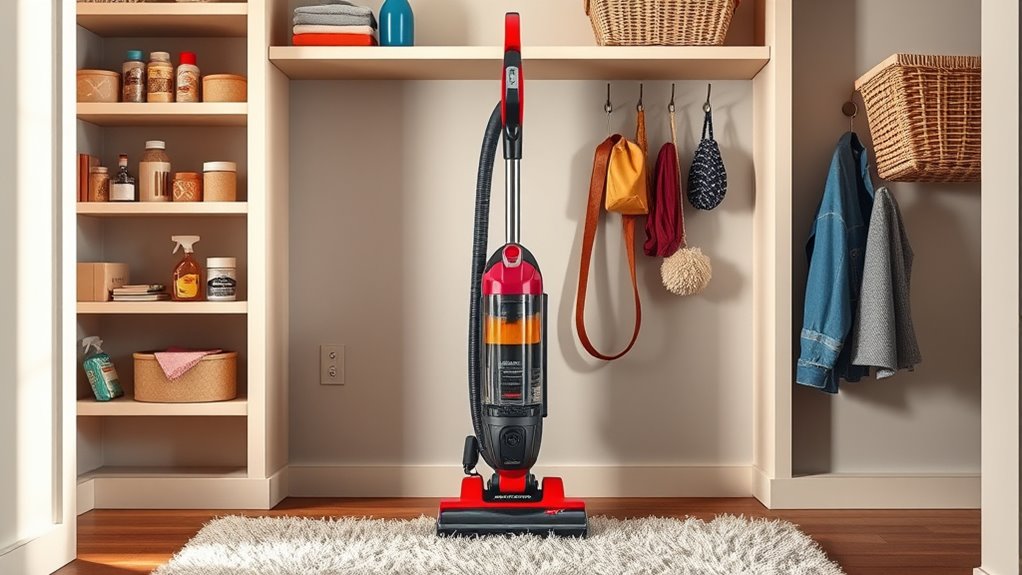
While finding the right storage location for your vacuum is important, getting creative with your storage solutions can make all the difference in maximizing space and accessibility.
Consider using wall-mounted hooks to store your vacuum cleaner, especially for cordless models, keeping it upright and within reach. For compact vacuums, under-bed storage allows you to hide them while keeping them accessible. Regularly checking for optimal usage timing can also help you determine when to have your vacuum ready for immediate use. Additionally, having a designated spot for your vacuum ensures that it remains free from potential damage caused by clutter or improper storage. Regular maintenance, such as washing filters and inspecting hoses, can also enhance the vacuum’s performance.
Maximize your space by using wall-mounted hooks for cordless vacuums or hiding compact models under the bed for easy access.
Repurpose utility rooms or broom closets with pegboards and shelves for organizing accessories alongside the vacuum itself. Invest in multifunctional furniture with designated compartments for vacuum storage to enhance aesthetics and functionality.
Custom-built cabinets or stylish baskets can discreetly store vacuums in common areas, ensuring air circulation to prevent damage while blending seamlessly with your home decor. Additionally, incorporating preventive maintenance strategies into your vacuum care routine can help prolong its lifespan and efficiency.
Protect From Dust and Damage

To keep your vacuum in top shape, it’s essential to protect it from dust and damage during storage.
Follow these tips to guarantee your cleaner stays in peak condition:
- Use a breathable fabric cover to shield against dust while allowing air circulation.
- Regularly inspect for signs of wear, pests, or moisture.
- Disassemble removable parts and store them in a labeled box for better organization.
- Avoid plastic covers; they can trap moisture and lead to rust.
- Store your vacuum in dry areas to prevent rust and damage from moisture.
Seasonal and Long-Term Storage Tips

When you’re preparing to store your vacuum for an extended period or just for the season, it’s crucial to take steps that protect its performance and longevity.
Start with a thorough cleaning to guarantee all dust, debris, and hair are removed, which helps maintain suction power and prevent odors. Regular maintenance practices, such as cleaning HEPA filters, can extend the life of your vacuum and improve air quality.
If you have cordless vacuums, charge the batteries to around 50% for peak performance.
Check that filters are clean and completely dry to avoid mold growth.
For vacuum cleaner storage, choose a climate-controlled space, avoiding damp areas like basements to prevent moisture damage.
Additionally, consider using moisture-proof containers and keep the vacuum away from existing furniture to maximize your storage space and make sure your vacuum remains in great condition. Proper storage is essential in maintaining optimal performance for your vacuum cleaner over time.
Frequently Asked Questions
Where Should I Store My Vacuum if I Don’t Have a Closet?
If you don’t have a closet, consider storing your vacuum under furniture like beds or tables for easy access.
You can also use dedicated cabinets or shelving units in places like your laundry room or garage to protect it from dust.
Hanging your vacuum on wall-mounted hooks in hallways saves floor space, while furniture with built-in storage can cleverly conceal it.
Get creative with pegboards or customized racks to organize your vacuum and its accessories!
Should I Keep My Vacuum Plugged In?
Keeping your vacuum plugged in is like leaving a car engine running all night—it wears it down. You shouldn’t keep your vacuum plugged in after you’ve finished using it.
This can lead to overheating, especially in older models, and can drain your cordless vacuum’s battery. Unplug it once you’re done to protect its motor and extend its lifespan.
Think of it as giving your vacuum a well-deserved rest, just like you deserve after a long day!
How Do I Protect My Vacuum Cleaner?
To protect your vacuum cleaner, start by cleaning it thoroughly before storage, ensuring the dustbin is empty and filters are clean.
Use a breathable fabric cover to shield it from dust while allowing air circulation.
Store it in a cool, dry place to prevent humidity damage.
Regularly inspect for wear and damage, and keep the power cord neatly wrapped to avoid tangles and fraying.
These steps will help keep your vacuum in top condition.
Should You Empty the Vacuum After Every Use?
Yes, you should definitely empty your vacuum after every use.
It helps maintain suction power and prevents odors from lingering. Leaving debris inside can lead to clogs and reduced efficiency, making it harder for your vacuum to work effectively.
Plus, a full dustbin can create a breeding ground for bacteria and mold, which isn’t great for your health.
Conclusion
Now that you’ve learned the essential steps to store your vacuum safely, imagine opening that closet door in a few months. Will you be greeted by a pristine machine, ready to tackle dust and dirt, or a dusty relic in need of rescue? By following these tips, you can guarantee your vacuum stays in top shape, ready for action whenever you need it. Don’t let neglect ruin your trusty cleaning companion—store it right, and watch it thrive!
